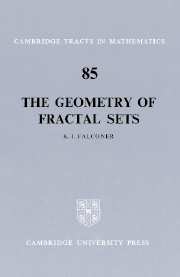Book contents
- Frontmatter
- Contents
- Preface
- Introduction
- Notation
- 1 Measure and dimension
- 2 Basic density properties
- 3 Structure of sets of integral dimension
- 4 Structure of sets of non-integral dimension
- 5 Comparable net measures
- 6 Projection properties
- 7 Besicovitch and Kakeya sets
- 8 Miscellaneous examples of fractal sets
- References
- Index
4 - Structure of sets of non-integral dimension
Published online by Cambridge University Press: 25 January 2010
- Frontmatter
- Contents
- Preface
- Introduction
- Notation
- 1 Measure and dimension
- 2 Basic density properties
- 3 Structure of sets of integral dimension
- 4 Structure of sets of non-integral dimension
- 5 Comparable net measures
- 6 Projection properties
- 7 Besicovitch and Kakeya sets
- 8 Miscellaneous examples of fractal sets
- References
- Index
Summary
Introduction
This chapter examines local properties of s-sets in ℝn for nonintegral s. The fundamental result is that any such set is irregular, that is, has lower circular or spherical density strictly less than 1 at almost all of its points. Indeed, the stronger result that its density fails to exist at almost all of its points has also been established. As before, we also examine the existence of suitably defined tangents, and show that the set of points at which such tangents exist must have measure zero.
For the case of subsets of the plane, the work is entirely due to Marstrand (1954a, 1955), the former paper providing a very complete account. As with sets of integral dimension, higher-dimensional analogues present formidable difficulties; the natural generalizations were eventually proved by Marstrand (1964).
s-sets with 0 < s < 1
First we consider s-sets in ℝn for s strictly less than 1. In this case the basic properties, including non-existence of the density almost everywhere, are relatively easy to obtain.
The following topological observation about such sets is sometimes useful.
Lemma 4.1
An s-set E in ℝnwith 0 < 5 < 1 is totally disconnected.
Proof. Let x and y be distinct points in the same connected component of E. Define a mapping f:ℝn →[0, ∞) by f(z) = |z–x|. Since f does not increase distances it follows from Lemma 1.8 that ℋs(f(E)) ≤ ℋs(E) < ∞. As 5 < 1 it follows that f(E) is a subset of ℝ of Lebesgue measure zero and, in particular, has dense complement.
- Type
- Chapter
- Information
- The Geometry of Fractal Sets , pp. 54 - 63Publisher: Cambridge University PressPrint publication year: 1985



